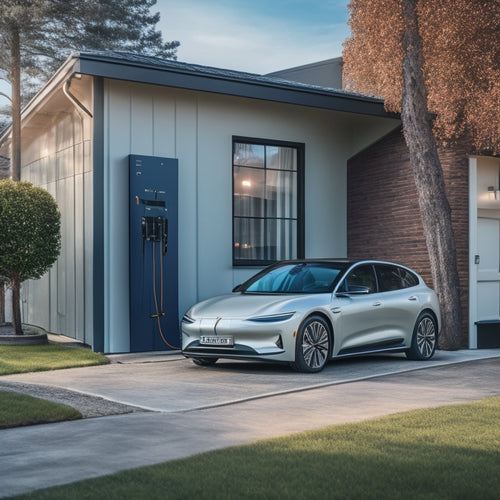
5 Best Ways to Fix Inverter Problems Fast
Share
When your inverter system fails, you need to act fast. Start by identifying error codes using your user manual or online documentation, and prioritize fault codes to tackle the most critical issues first. Next, inspect wiring connections for signs of damage or corrosion, and clean or replace components as needed. Verify your grid tie functionality, ensuring your inverter can adapt to changes in grid frequency and voltage. Don't forget to inspect for overheating and update your firmware safely. By following these steps, you'll be well on your way to fixing your inverter problems quickly and getting back online. Now, take the next step to resolving your issue.
Key Takeaways
• Identify inverter error codes using user manuals, online documentation, and built-in diagnostic tools to prioritize and fix faults efficiently.
• Inspect wiring connections for signs of damage, corrosion, or looseness, and clean or replace components as needed to prevent issues.
• Verify grid tie functionality by confirming frequency and voltage synchronization to ensure efficient energy output and stable grid operation.
• Regularly inspect the inverter for overheating, using thermal imaging to detect hotspots, and clean or replace cooling components to prevent efficiency loss.
• Update inverter firmware safely by accessing the manufacturer's website, backing up data, and verifying the correct update to prevent disruptions.
Identify Inverter Error Codes
When troubleshooting an inverter issue, deciphering error codes is your first step towards a swift resolution. Think of it as cracking a secret code - once you understand the error codes, you're halfway to fixing the problem.
So, where do you start? Begin by consulting your inverter's user manual or online documentation to identify the specific error code classification. This will help you categorize the error into categories like electrical, mechanical, or software-related issues.
Next, prioritize the fault codes using a fault code prioritization strategy. This means addressing the most critical errors first, such as those affecting safety or system performance. Don't worry; it's not as challenging as it sounds.
Most modern inverters come with built-in diagnostic tools that can guide you through the process. By following these steps, you'll be well on your way to identifying and fixing the root cause of the problem.
Check Inverter Wiring Connections
Next, inspect the inverter's wiring connections. Loose or corroded connections can masquerade as error codes, so it's essential to verify that all cables are securely connected to the correct terminals. Check for signs of wire damage, such as frays, cracks, or exposed wires. If any damage is found, replace the affected wires to prevent further issues.
Inspect the connections themselves. Look for signs of connection corrosion, such as rust or greenish buildup, which can prevent a solid connection. Clean any corroded terminals with a wire brush and reconnect the cables. Ensure all connections are snug and secure, but avoid overtightening, as this can damage the terminals.
Verify Grid Tie Functionality
Verify that your grid tie inverter is functioning correctly by checking its ability to synchronize with the grid frequency, as any mismatch can prevent the inverter from feeding power back into the grid. You don't want your inverter to be out of sync, it's like trying to dance to a different beat - it just won't work!
To make sure your inverter is in harmony with the grid, check the following:
-
Grid stability: Confirm that the inverter can adapt to changes in grid frequency and voltage. A stable grid is vital for efficient energy output.
-
Synchronization: Validate that the inverter's output frequency matches the grid frequency. This ensures a smooth flow of energy back into the grid.
-
Energy output: Verify that the inverter is producing energy at the correct voltage and current levels. This will guarantee maximum energy output and prevent damage to the inverter.
Inspect for Inverter Overheating
Check your inverter's temperature regularly, as excessive heat can greatly diminish its lifespan and efficiency. Think of it like keeping an eye on your car's engine temperature – you don't want it to overheat and leave you stranded!
When inspecting for overheating, make sure you're in a well-ventilated area, and the inverter is turned off. Next, visually inspect the exterior for signs of overheating, such as burn marks, rust, or corrosion.
Now, it's time to get technical! Use thermal imaging to detect hotspots and identify potential issues. This will help you pinpoint areas that need attention. Don't forget to check the cooling systems, like fans or heat sinks, to make sure they're functioning properly. Clean or replace them as needed.
Update Inverter Firmware Safely
You'll need to access the inverter's firmware update portal, typically found on the manufacturer's website, to make sure you're getting the latest authorized updates. This is important in fixing inverter problems fast.
Before you start, make a Firmware Backup to prevent any data loss during the update process. It's always better to be safe than sorry!
When updating your inverter's firmware, keep the following in mind:
- Cloud Updates can be convenient, but make sure your internet connection is stable to avoid interruptions.
- Verify the firmware version and release notes to make sure you're getting the correct update.
- Disable any firewalls or antivirus software that might disrupt the update process.
Frequently Asked Questions
Can I Fix My Inverter Problem on My Own Without Professional Help?
"Hey, DIY enthusiast! If you're wondering if you can fix your inverter problem solo, the answer is yes, but only if you've got DIY confidence and take necessary Safety precautions, like shutting off power and using protective gear."
How Often Should I Perform Routine Maintenance on My Inverter?
You should perform routine maintenance on your inverter every 3-6 months to guarantee peak performance and extend its lifespan. Create a maintenance schedule to track checks, guaranteeing your inverter stays happy and healthy!
Are Inverter Problems Usually Caused by Manufacturing Defects or User Error?
When you buy an inverter, you're probably wondering if it's gonna fail due to manufacturing defects or your own mistakes. Honestly, it's a mix of both, but quality control issues and design flaws are often to blame, so don't be too hard on yourself!
Can I Use a Different Brand of Replacement Parts for My Inverter?
When replacing inverter parts, you'll wonder if you can mix and match brands. The answer lies in brand compatibility and cross-compatibility; check your inverter's manual or manufacturer's website to confirm that the replacement parts you choose won't void your warranty or cause more harm.
Will Fixing My Inverter Void Its Warranty or Guarantee?
"When fixing your inverter, you're wondering if it'll void the warranty or guarantee. Check the manufacturer's policies, as some allow DIY repairs while others don't; understand the warranty implications to avoid voiding it, and you'll be golden!"
Related Posts
-

5 Essential Tips for Buying EV Charging Systems Online
When purchasing an EV charging system online, you'll want to make sure you're making an informed decision. First, det...
-

Top 10 DIY Conversion Kit Reviews and Tips
You're taking the first step towards electrifying your ride, and with the right DIY conversion kit, you'll be cruisin...
-

10 Best Solar Panel Options for Motorhomes Online
When choosing the best solar panel for your motorhome, consider factors like efficiency, durability, and design. You'...


